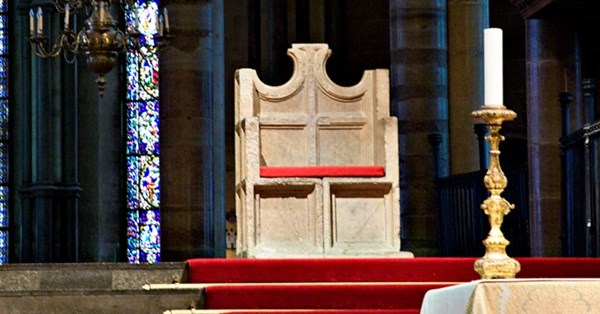THE Archbishop in Jerusalem, Dr Hosam Naoum, is to be one of the five representatives of the global Anglican Communion who help to decide the next Archbishop of Canterbury.
The names of the Communion representatives were announced on Tuesday morning, along with those selected from among the central members elected by the General Synod for a five-year term.
Previously, the Canterbury Crown Nominations Commission (CNC) has had only one representative of the Anglican Communion, but this was increased to five after a Synod vote in 2022 (News, 9 July 2022).
There is one representative for each of the five continents. Dr Naoum is listed as the representative for Asia, and is joined by another member of the episcopate: the Bishop of Llandaff, the Rt Revd Mary Stallard, representing Europe.
Oceania is represented by Canon Isaac Beach, who serves in the Anglican Church of Aotearoa, New Zealand and Polynesia. According to a 2019 story on the Anglican Communion News Service, he was previously a youth representative on the Anglican Consultative Council, and is a Maori of Ngati Porou, Ngati Kahungunu, and Ngati Rangitihi descent.
The representative from Africa is the Revd Professor Grace Nkansa Asante, who teaches economics at Kwame Nkrumah University of Science and Technology in Kumasi, Ghana. The university’s website says that she is also a priest serving at the Archbishop Thomas Cranmer Church on the campus.
The only lay Communion representative is Joaquín Philpotts, an industrial engineer from Buenos Aires, representing the Americas. He currently represents the Anglican Church of South America on the Anglican Consultative Council, and is a lay minister.
A spokesperson for the Anglican Communion Office said that the representatives were confirmed by the Standing Committee of the Anglican Consultative Council (ACC) this month. “Each Province was asked to bring names that met the criteria to regional discussion which took place at the Primates’ Meeting in April,” the spokesperson said.
The Standing Orders of the General Synod do not specify how the representatives from the Communion are to be chosen, but set out criteria: that the five members include at least one primate, one priest or deacon, and one lay person; that the members include at least two men and two women; and that at least three of the members are of Global Majority Heritage.
A shortlist of three names from each region were put forward to the Standing Committee of the ACC, which made the final nominations in accordance with the criteria.
The CNC’s central members are drawn from those elected by the General Synod in 2022. Six pairs of representatives were elected, three lay and three clergy. Ordinarily, one of each pair would sit on any given diocesan CNC. Several have ceased to be Synod members since 2022, however, and so are no longer eligible.
This means that several members were, in effect, already certain to be part of the CNC, as they were no longer part of a pair. Christina Baron (Bath & Wells) and Clive Scowen (London) were in this position, and were duly in the list announced on Tuesday, together with Debbie Buggs (London).
The clergy representatives are the Revd Claire Lording (Worcester), the Revd Lis Goddard (London), and Canon Paul Cartwright (Leeds). Canon Cartwright was not elected as part of a pair, but has been selected as a replacement for the pair of Canon Andrew Cornes (Chichester) and the Revd Paul Benfield (Blackburn).
Canon Cornes is currently subject to a Clergy Discipline Measure process over his handling of disclosures of John Smyth’s abuse (News, 28 February) and was not expected to take part in the CNC.
A spokesperson for Lambeth Palace confirmed that Fr Benfield was also not taking part in the process, and had not nominated a replacement, leaving the decision to the Prolocutor of the Lower House of the Convocation of York, the Revd Kate Wharton
Fr Benfield has been approached for comment.
The only CNC members still to be announced are the diocese of Canterbury representatives, to be chosen by the vacancy-in-see committee. The election of the committee, however, has been beset by procedural issues.
A version of the committee constituted before the resignation of Archbishop Welby was deemed not to have been properly elected, owing to candidates’ being drawn solely from the diocesan synod.
A subsequent election to the committee held in early 2025, however, was also later considered improperly conducted under Rule 75 of the Church Representation Rules, which states that someone who will automatically be elected owing to a lack of other eligible candidates should be removed from the voting paper.
The full membership of the Canterbury CNC was supposed to be announced in mid-March, in time for a planned first meeting in May. The Church Times understands that a May meeting may still be possible, as the election process for the vacancy-in-see committee is to be re-run later this week.
The CNC for Canterbury is completed by the Archbishop of York and the Bishop of Norwich, the Rt Revd Graham Usher, who was elected by the House of Bishops as the episcopal representative for the Southern Province (News, 19 March).
As CNC members, Archbishop Cottrell and Bishop Usher cannot be chosen as the next Archbishop of Canterbury. In March, Bishop Usher said: “Despite speculation in recent months, I have felt no sense of inner calling to be Archbishop of Canterbury.”
As CNC members, Bishop Stallard and Dr Naoum are also ineligible.
Lord Evans of Weardale, a former director-general of MI5 and a cross-bencher in the House of Lords, is to chair the CNC (News, 20 December 2024).
















